Key takeaways:
- Homelessness advocacy requires understanding both individual stories and broader social contexts that influence the issue.
- Effective policy advocacy can lead to meaningful change by amplifying the voices of those affected by homelessness directly to decision-makers.
- Building community partnerships with organizations and local entities enhances the impact of advocacy efforts and fosters mutual benefits.
- Measuring advocacy impact involves both personal narratives and building supportive relationships that lead to actionable policies.
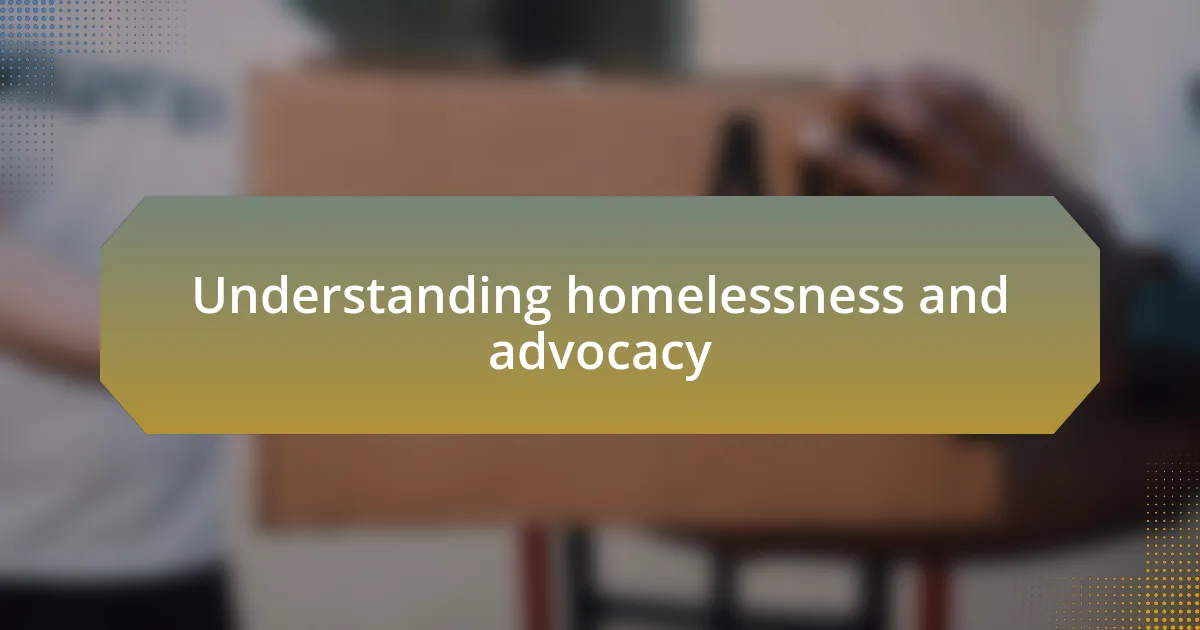
Understanding homelessness and advocacy
Homelessness is not just a lack of shelter; it’s a complex issue intertwined with mental health, economic instability, and systemic barriers. I remember speaking with a woman at a local shelter who described her daily struggle to find a safe place just to sleep. Listening to her, I realized that each individual’s story adds a unique layer of urgency to our advocacy efforts—how can we ignore the lived experience behind the statistics?
When advocating for those facing homelessness, it’s essential to understand the broader social context that influences their situation. I often reflect on the times I’ve walked by encampments—how can any of us dismiss those reminders of our shared humanity? Advocacy isn’t just about policy changes; it’s about amplifying the voices of those who feel invisible in our society.
Engaging in policy advocacy allows us to challenge the status quo and push for solutions that truly address the needs of the homeless population. I once attended a town hall meeting where a homeless veteran shared his perspective, and it struck me how the right policies can foster genuine connections and change lives. How could we not take action after hearing such heartfelt testimonies?
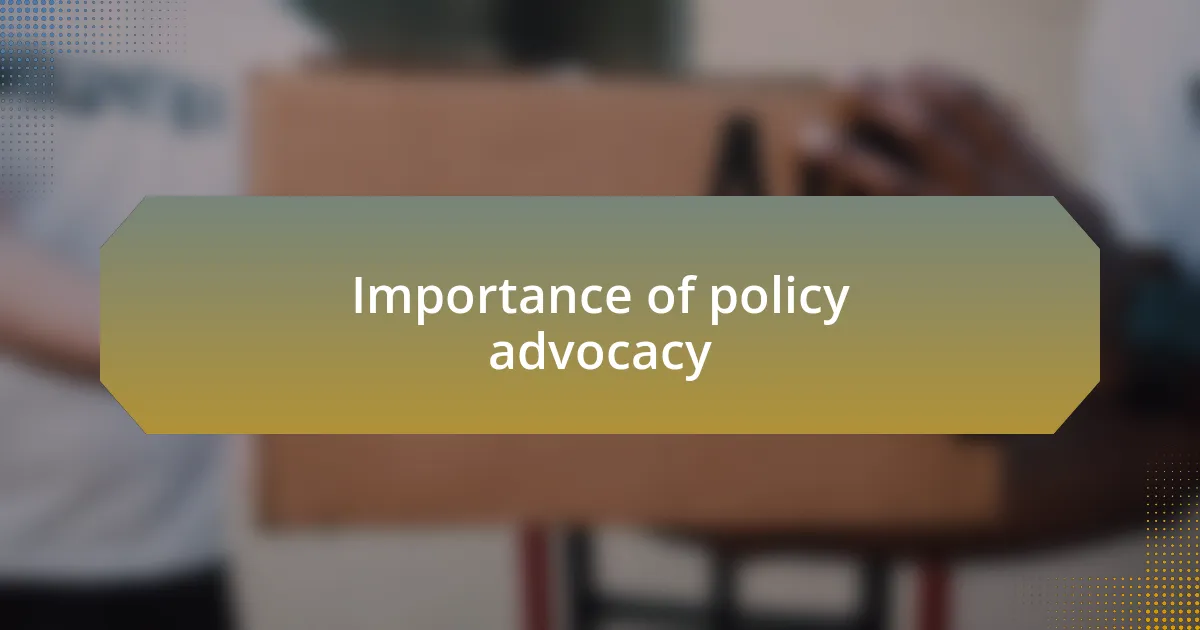
Importance of policy advocacy
When I first got involved in policy advocacy, I quickly learned that it serves as a powerful tool to effect change. I recall attending a workshop where a panel of advocates discussed the laws that directly impact funding for shelters and mental health services. Hearing firsthand how these policies shape the resources available to vulnerable populations made me realize that advocating for policy reform can literally be a lifeline for those experiencing homelessness.
Policy advocacy isn’t just about pushing for new laws; it’s about challenging outdated systems that perpetuate cycles of poverty and neglect. One poignant moment for me was when a friend who runs a local charity shared her frustrations about bureaucratic obstacles. It hit me hard—how many more personal stories are lost when policies remain stagnant? This emotional connection drives home the importance of ensuring that our advocacy efforts push for frameworks that not only support individuals but empower them.
The impact of effective policy advocacy can ripple out, creating lasting change for communities. I remember engaging with a group of legislators who were genuinely moved by a presentation from homeless youth, and it was evident that their perspectives shifted as a result. This experience reinforced my belief that policy advocacy is crucial; it allows us to connect the stories of those most affected by homelessness directly to the decision-makers, fostering empathy where it’s most needed. How can we not strive for that important connection?
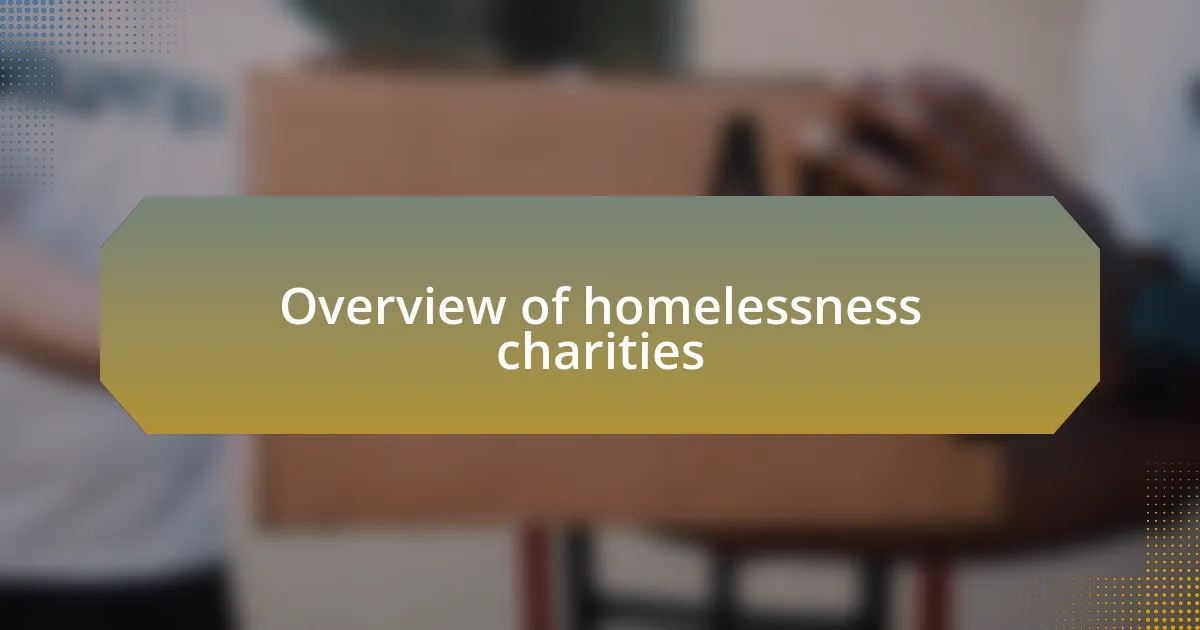
Overview of homelessness charities
Homelessness charities play a critical role in addressing the complex challenges faced by those without stable housing. I’ve seen firsthand how these organizations often serve as a first touchpoint for individuals seeking assistance, providing vital resources like food, shelter, and access to healthcare. It’s remarkable to witness how a single charity can become a lifeline, reestablishing a sense of dignity and hope for individuals who may feel invisible in society.
Through my experiences, I’ve learned that every charity operates with its unique mission and methods, yet all share a common goal: to uplift those experiencing homelessness. I remember volunteering at a local shelter where we organized a warm meal distribution. The gratitude and smiles from those we served were incredibly moving; it reminded me that these charities create not just programs but genuine connections within communities that help break down barriers. How often do we take for granted the simple act of sharing a meal or conversation?
Moreover, effective homelessness charities often advocate for systemic change, recognizing that addressing immediate needs is just one piece of a larger puzzle. I recall a heartfelt discussion with charity leaders who emphasized the importance of policy reform in housing. Their passion for creating sustainable solutions was infectious, and it made me reflect on how important it is for these organizations to amplify their voices. After all, if we don’t advocate for broader changes, can we truly hope to end the cycle of homelessness?
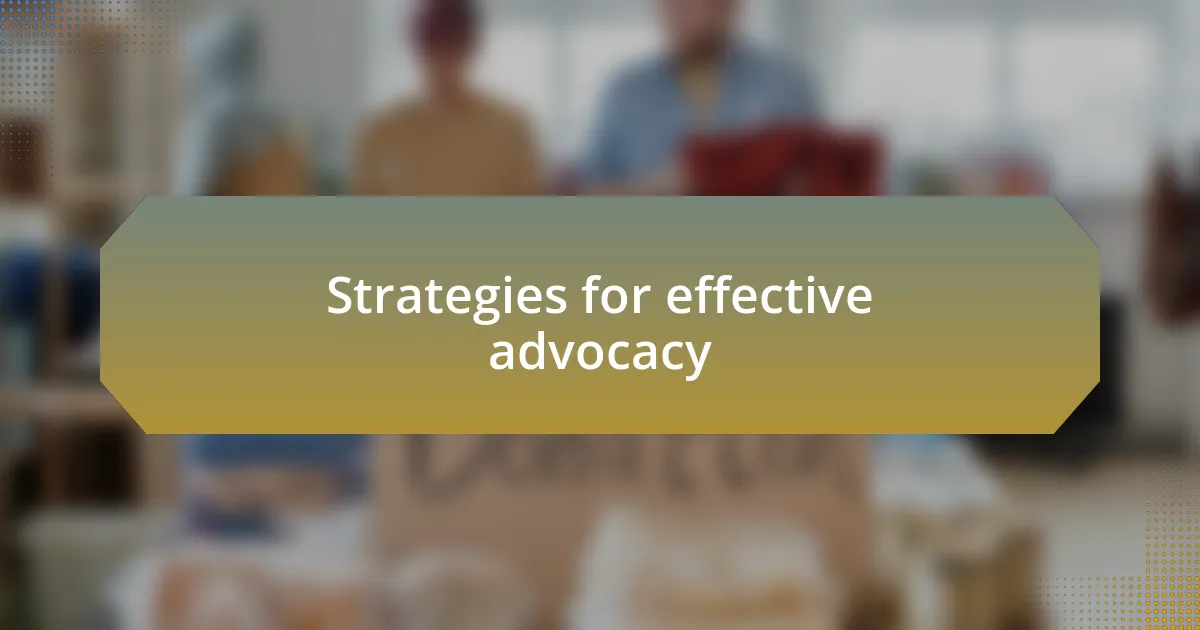
Strategies for effective advocacy
When it comes to effective advocacy, one of the strategies I’ve found to be crucial is building alliances with other organizations. I once collaborated with a group focused on mental health services, and together we created a comprehensive resource guide for homeless individuals. This partnership not only expanded our reach but also highlighted the interconnectedness of issues. It made me realize how much stronger our voices can be when we unite with others who share a common cause. Have you ever noticed how collaboration can amplify impact?
Another powerful strategy is storytelling. I remember attending a community meeting where a previously homeless individual shared their journey. Their vulnerability and authenticity transformed the atmosphere, sparking deep discussions about misconceptions surrounding homelessness. It was a moment that taught me the profound impact personal stories can have on policy decisions. How often do we underestimate the power of a single narrative to sway hearts and minds?
Lastly, consistent engagement with local policymakers is vital. I’ve reached out to city officials to discuss homelessness initiatives, bringing firsthand accounts from the individuals I’ve encountered. This direct line of communication helps put a face to the statistics and often leads to more informed decision-making. I believe that when advocates prioritize these relationships, they pave the way for meaningful change. Isn’t it fascinating how even a simple conversation can open doors to transformation?
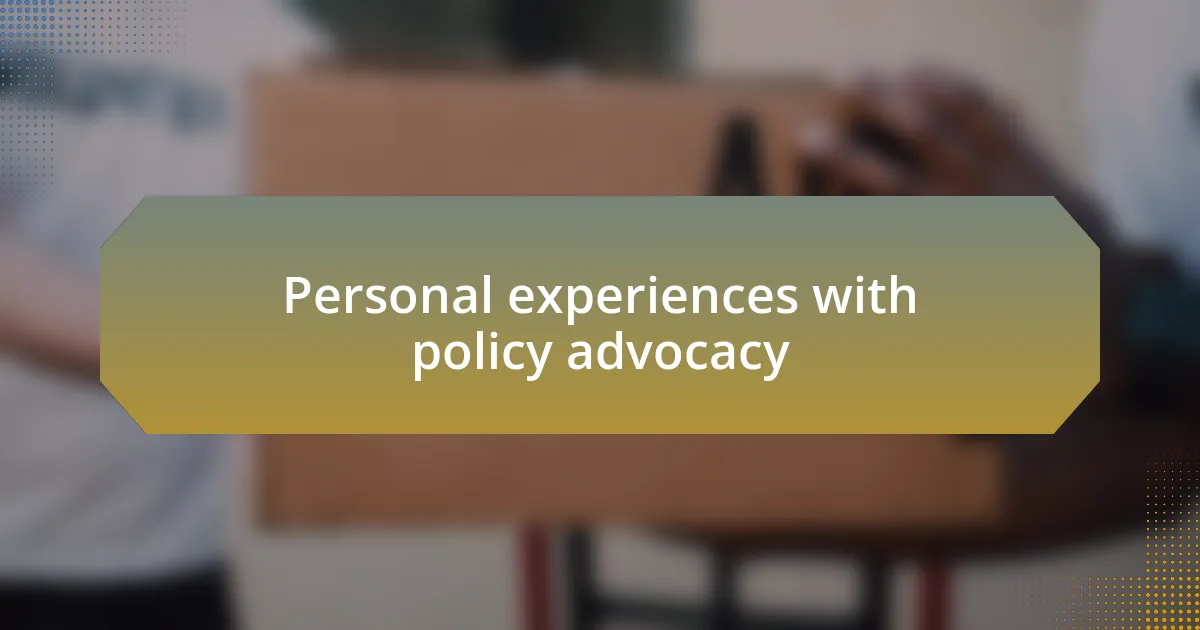
Personal experiences with policy advocacy
Engaging directly with policymakers has been a defining aspect of my journey in advocacy. I recall a particular city council hearing where I shared my experiences volunteering at a local shelter. The palpable tension in the room shifted as I narrated the story of a young man I met there, whose dreams were derailed by circumstances. Isn’t it remarkable how personal stories can change the dynamic and make the issue more relatable to those in power?
In another instance, I participated in a rally advocating for affordable housing. Standing among a diverse group of individuals, each with their own unique challenges, I felt an overwhelming sense of solidarity. That day, I realized that the emotions we channel in advocacy—whether hope, frustration, or determination—are what truly resonate with those who can enact change. Have you ever felt that surge of collective energy while advocating for a common cause?
One memorable experience involved quick action when a new policy threatened funding for homelessness programs in our city. I organized an email campaign urging community members to voice their concerns to legislators. Witnessing the flood of responses was exhilarating; it reminded me of the power of grassroots mobilization. Don’t you think that when individuals come together, they can create an unstoppable force for change?
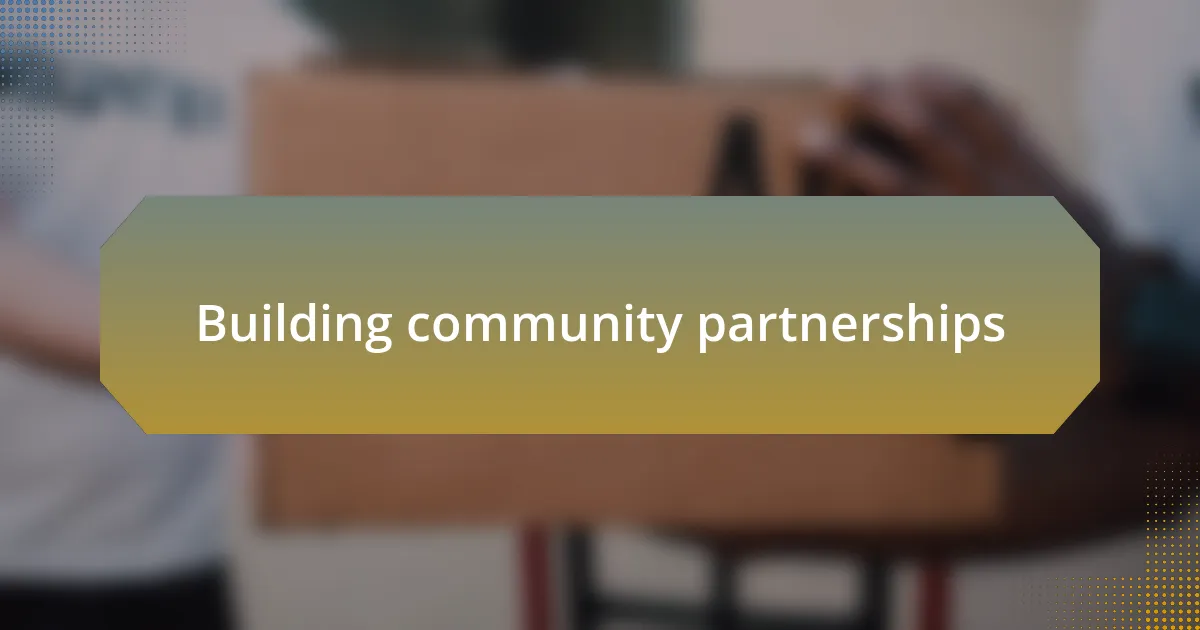
Building community partnerships
Building community partnerships has been pivotal to my advocacy efforts. I remember working closely with a local business that allowed us to host a fundraiser in their space. Seeing the owner excited about our cause made me realize how investment from local entities could amplify our reach. Have you ever noticed how a single partnership can breathe new life into a project?
Through these collaborations, I learned the importance of mutual benefits. At one point, we teamed up with a nearby college, engaging students in volunteering and raising awareness about homelessness. Watching them develop a deeper understanding of community issues was rewarding. Can you imagine the impact when young voices join in advocating for change?
In another instance, we partnered with healthcare providers to bridge services for those experiencing homelessness. It was eye-opening to witness the transformative effects of such partnerships on individuals’ lives. The gratitude expressed by those we helped was a powerful reminder that when communities unite, they can provide more than just basic needs—they can restore dignity and hope. How fulfilling is it to see the direct outcomes of working together toward a common goal?
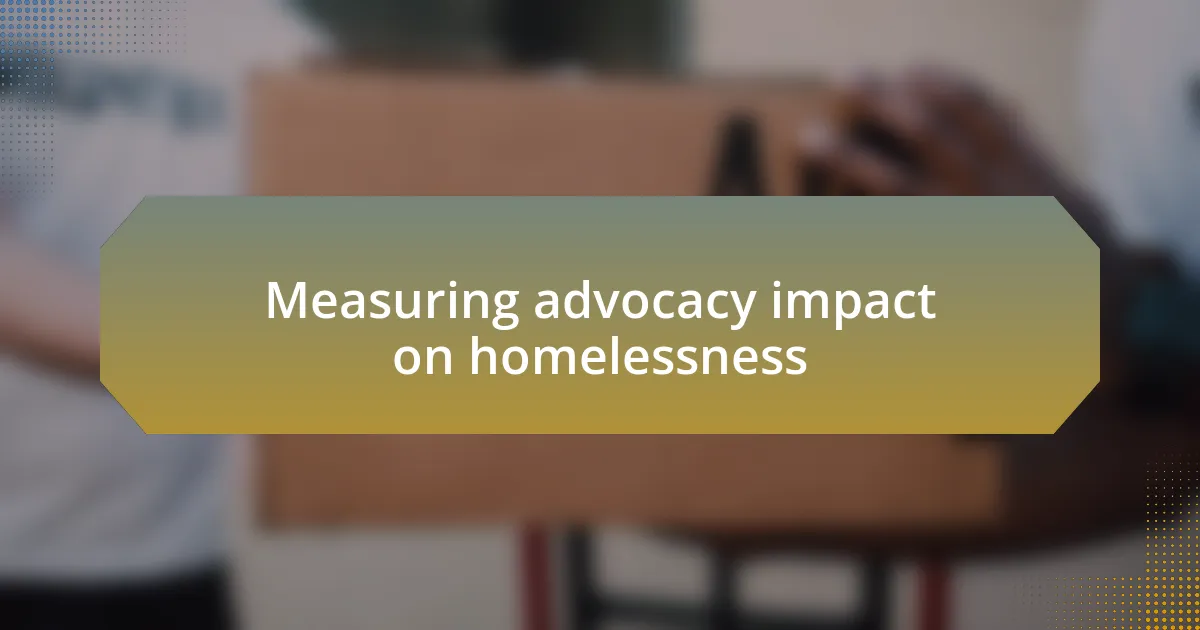
Measuring advocacy impact on homelessness
Measuring the impact of advocacy in homelessness is a nuanced process that requires a combination of quantitative and qualitative data. I once participated in a project where we surveyed individuals who had accessed our resources. The shift in their narratives—from feeling hopeless to reclaiming their lives—was a clear indicator of our advocacy’s influence. Isn’t it often those personal stories that resonate the most?
Another key aspect of measuring impact is the relationships we build. During a community meeting, I witnessed how local leaders transformed our proposed initiatives into actionable policies. Their support was palpable, and seeing their commitment encouraged others to join us. Have you considered how passionate advocates can inspire others to see beyond statistics?
Finally, the feedback loop we create is vital. Hosting a forum where stakeholders could openly discuss our initiatives provided insights that reshaped our approach. The conversations weren’t always easy, but they brought forth a wealth of perspectives that directly influenced our next steps. When was the last time you engaged in such honest dialogue to evaluate the effectiveness of your own efforts?